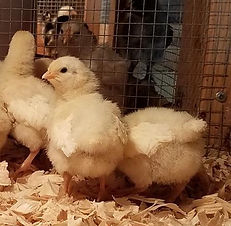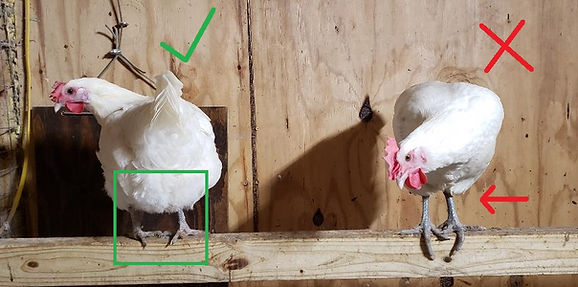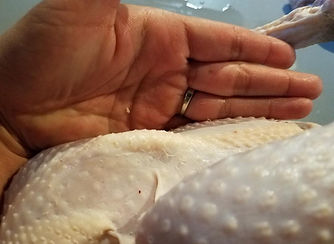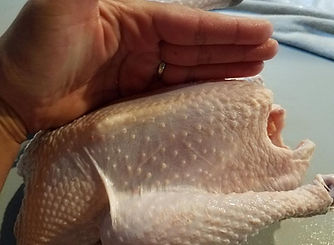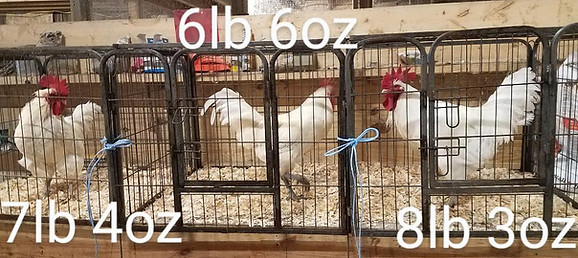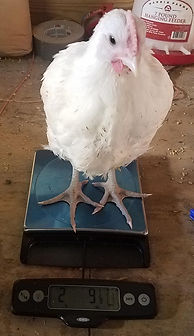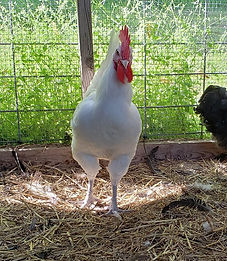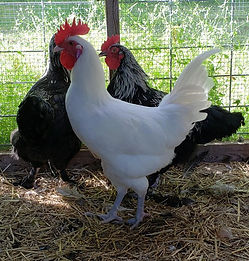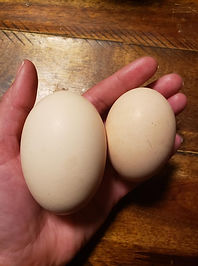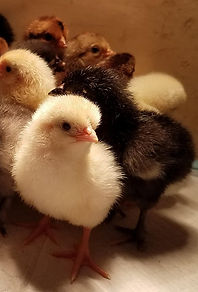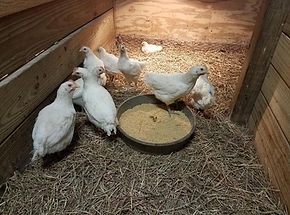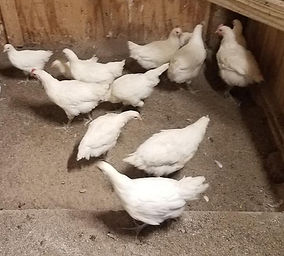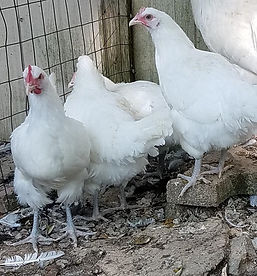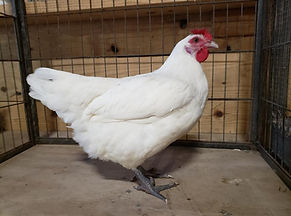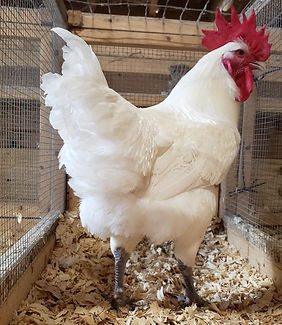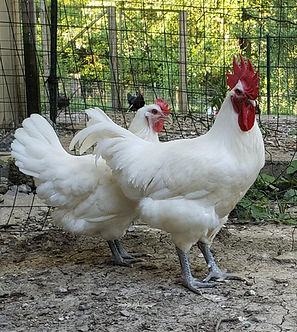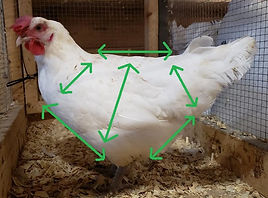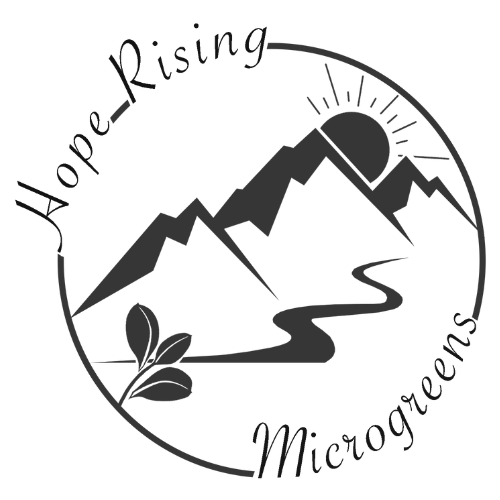American Bresse Selection Guide
Selecting the Next Generation for Success
By Mandelyn Royal
American Bresse Selection Guide: Helping you achieve target traits in your flock.
Everything about a chicken is decided before the egg is ever hatched, if they are in the proper environment for them to reach their genetic potential.
The below writings and musings are assuming that the flock has the appropriate space, quality feed, fresh water and no known environmental concerns that could affect their growth.
In all poultry, hidden recessive traits and expressed undesired traits are common, in all breeds.
The purpose of the American Poultry Association is to issue a standard of the ideal for breeders to aim at. There is no PERFECT bird! All flocks are in a constant state of development and when you buy into a flock, you're buying into where they are currently in their development, with more work to be done in order to get a large percentage of them pretty close to "The Standard of Perfection."
The work never stops and selection happens with every hatch.
A flock will ultimately become the epitome to the eye of their breeder. Under their selection and guidance, the flock will evolve from one season to the next. The standard exists so that everyone is aiming in the same direction, honed in with the breeder's eye.
There are numerous traits in chickens that are considered "good chicken" in a number of breeds and I'll focus on those first, along with their corresponding flaws that can occur within the same hatch.
Selection Guide: American Bresse General Body Conformation
Body structure matters the most. It's their body that can yield breakfast or dinner. When they lay, they need to have the pelvic space and the capacity for ease of laying. If they're to be dinner, they should have the frame to carry their fleshing. The larger they are to be, the more time it will take for them to grow. The more they are to lay, the better their body needs to be equipped to handle it.
Medium Size, Fine Bone
The American Bresse should be of medium body... not too big and not too small. Fine boned, for an elegant look, without being fragile. A solid and well fleshed bird that is neither giant nor small.
The males will grow much faster than the females but both should feel hefty when you handle them. Both genders should have strong fleshing down the keel line and you shouldn't feel a bony breast. They should feel this way from the beginning, at just a couple of weeks old. They'll out grow just about any other breed you have them growing with, supposing that the others aren't commercial meat birds.
Width of Body
Width of body matters a lot, it's the bulk of their shape. It's the width that decides the breadth of carcass and the capacity for laying (in addition to depth and length) and their body shape affects how their inner organs will be able to function. Height plays a role as well, if they're too tall they may experience leg weakness, knock knees, or decreased growth speed (think of a Turkey growing for height first and meat later). I have not found issue with them being too short, besides a lack of balance in their look.
Since the American Bresse are a dual purpose bird, how they dress out is important. Their keel line should be well formed. Part of selecting birds is learning what they should feel like, so that you can assess birds with their feathers on. Though with the feathers off will SHOW you more.
The keel should not be bent, twisted or caved in. This can happen from injury or genetics, regardless though I feel that ONLY a straight and true keel line should be considered for breeding.
The examples above are 16 week old cockerels. The one with the straight and full keel line had other flaws and the other had the bowed in/hollow chest in addition to other flaws. Around here, it's our flawed birds that come to dinner, for the betterment of the future flock. The keel is the center bone of the breast and can be felt easily, unless they're buried in meat to make it trickier.
Feel on your birds often to get familiar with the shapes and sizes that they may express.
Undercarriage
What you want to feel for in their under carriage is a good 4 finger width between their legs. This will of course vary by hand size but when you're running through a sorting marathon, peer against peer, your hand is a handy measuring device to have on hand. Then you want to feel for straightness and fleshing, and base the quality off of the other birds you handled before and after.
The Standard is the Measuring Stick
When you're sorting through birds, you don't want to have pictures of other live birds in mind beyond the bare basics. You want to go off of the interpretation of the standard and how the flock you have measures up against that, since no one has the perfect bird. If you aim at a picture of a live bird, you may get some things skewed by another breeder's perception of the standard. Your goal is to develop the flock to the standard and not to the flock of another.
Selection Guide: Evaluating Size/Weight
On sort day, I like to have a scale handy. That way I can see the real number of what I'm handling. Through feel, I can assess where that weight is being carried, if the bird is heavier in the thigh or the breast or really not even weighing much of anything when compared to their peers. Females get weighed too, since they will throw their type and structure forward as well. Their type is their shape/outline and their structure is how they're put together.
Is bigger better? Sometimes. It boils down to what else the bird has to offer and what they throw forward once you start stalking the growth of their offspring from who they were paired with. Overall balance and closeness to the standard is the goal. When a variety or bloodline is a work in progress, you may have many choices on how to achieve the goal. A small male can be bred to a larger female, with balance of size achieved in some offspring, while also balancing their other traits. Perhaps the male had the great comb and tail and the female had the better wings and stance. Hopefully, at least some of the offspring pick up the best of both worlds.
It's important to note that when you're selecting your breeding groups, the birds involved should not share the same flaw/s when they're of the opposing gender. That will only serve to compound that flaw and make it express stronger in the next generation.
Selection Guide: Growth Rate (Early is Good)
This cockerel (pictured here) was 2 lbs 7 oz when he was 7 weeks old. We start looking at growth rate early, so that we can tag who's doing it better at that time. That way, come selection time, we know who did it faster than the others. I handle them through their growth phases and get the scale out for whom ever seems to be doing it faster, so that we can find the base line of what our peak expectations could be. Then we track those birds through the remainder of their growth and their subsequent offspring, if they happened to make it into a breeding pen.
This cockerel at 14 weeks old (pictured above) was the peak performer for growth, consistently since hatch, in his group. As he's been developing he has also shown excellent balance to his structure, gaining white in the earlobes, his feet have darkened and his other details have also been coming in well. Thus far he's been outperforming his hatch peers since the beginning, which bodes well for his future.
His features are coming in more delicate, which makes him look a bit more refined than what a thicker/stouter production bird would look like.
He is 1lb less in weight vs. his peers in our production type flock, which means he'll likely finish out right at standard weight for an adult when he's 1 year old.
From Hatching Eggs to Beyond
The goal is to have as many eggs as possible hatch well and easily. Selecting the best eggs that the flock is providing aids in this tremendously.
Selection Guide: Egg Shape and Quality
Some
things to consider is the shape of the egg, the shell quality and the size of
the egg. To some extent, you can pick for color of the shell as well, the
lighter the better. There is normal color variation in the shells, ranging from
medium tan to white. Typical is a light cream/beige.
The shape of the egg should be round at the top, tapering down to a rounded bottom. Avoid using eggs that are too narrow/long, as this will make it difficult for the chick to turn for zipping out of the egg. You want them to have good "elbow room" 1/3rd of the way from the top of the egg.
Candle the egg, to check for cracks, weak spots or excessive porosity in the shell texture. If the shell is too "dotted" or "mottled", this egg may release too much moisture or allow bacteria a way in. When you candle a batch of eggs on day 7, really take a look at how the shell looks in those that didn't develop. This may indicate a particular hen is having a dietary issue or something else that is affecting her shell quality negatively.
Here is some additional reading on hatching egg selection/quality and things to look for.
Egg Shell Porosity: https://www.sciencedirect.com/science/article/pii/S0032579119517023
Evaluating Poor Hatch
Results:
https://www.thepoultrysite.com/articles/investigating-the-reasons-behind-a-poor-hatch
Selection Guide for Chicks at Hatch
The first week is all about survival of the fittest.
In a perfect world, all of the chicks within a batch will hatch quickly and easily. There are a lot of variables to consider for the incubation and hatching process, more so in a shipped egg situation. Shipped chicks as well may need some extra care for stress.
You may find yourself having to decide about if you will help a chick or cull a chick, in the case of weak ones or if they came out with crooked toes or some other such thing. It's a personal choice, regardless. Just know that in every batch, you're specifically looking for those who thrive with routine care.
Keep an eye out for issues and correct what you can, following good husbandry methods and cleanliness.
Selection Guide: Chicks Week 2 - 6
Growth Rate
After the first week, you can start really watching their growth. You can do the first weigh in during the second week, to see who has a head start on growth.
Leg Color
Between
week 2 and 3, their leg color will be changing. How the blue legs develop
varies by bloodline, some change quicker than others. Some may get VERY dark
blue and others may be a paler blue. Usually by 8 weeks the color is
"set," but again, the final age for leg color may vary.
Weighing at week 4 and every 2-4 weeks from there is sufficient for monitoring their growth rate and making some early picks for who grew faster. This will matter if you want your table harvest to be prior to 22 weeks of age for cockerels.
Body Shape
Week 4 is when their body shape may begin to "round out" with width, if that's a trait that they carry strongly. Also by week 4-5, you should be seeing the signs of male or female, in the form of comb and wattle development. The boys brighten up with larger, colorful combs and wattles at a much earlier age than the females.
More Pen Space Please?!
You
will need to increase their space as they grow larger. Do your best to avoid
over crowding and always maintain clean pens. Between week 2 and week 6, their
space should double, at minimum.
Selection Guide: Chicks Week 7 - 9
By the 7 to 9 week old stage, growth rate should be apparent and size differences between the genders and individuals should be relatively obvious. Especially if you have gained familiarity with them over the first several weeks.
Consider how you will be housing them going forward, as they will be coming off of brooder heat and will need to be transitioned to grow out housing. Their space should, at minimum, double again from what it was. 8 weeks old is a good time to introduce them to forage/pasture access if you can ensure their safety. A lot of folks use pasture tractors to protect them.
Gender Separation
Ideally, the next housing move will lead to a separation of genders, before the male hormones really start coming in. This allows for a more peaceful flock with reduced competition. I like to put my favorite male or 2 with the pullets, so that I know where he is.
Selection Guide: Juveniles
Week 10 - 15
That "Wonky" Phase
At this stage they are molting, growing a lot of new feathers and they may be headed into a "wonky" phase as their skeleton changes during additional body growth. They should not lose fleshing/condition during this time, so it's a great age to sort them out for "meatiness" by feel. Weighing them also helps a lot to identify those coming into the best condition. Handle them to see what they feel like along the breast, keel line and thighs.
This
will be the time to consider if you will be doing a special finishing with the
birds you have designated for table use. Feel free to wait a little longer in
making those choices, until you have gained additional experience in what
you're looking for in your flock development and goals.
Appearance of Additional Traits
Also at this phase, the white earlobes will be making an appearance if they will be developed at all. It's a trait that the breed is known for and is part of the standard, though not all birds will get them if the trait wasn't selected and bred for as part of the breeding considerations.
Remember that you're looking for the best birds as the possible breeding birds and the lesser birds for the table, so that you can work at improving the flock season after season. It's through breeding selection that flock improvements are made. That's true for all breeds but especially Bresse.
Selection Guide: Juveniles Week 16 - 22
This age group is when they really start showing what they're made of and how their individual details measure up against the others. By this time they should have shown you who the top performers were for growth and fleshing. They should also be showing coloring in the legs and earlobes. If yellow feathers are going to be an issue, that may not show until 6 months to 1 year, after they molt again.
Prime Harvesting Age
It is also prime harvesting age for extra males, of those who likely do not warrant breeding forward within your own flock. Be sure to hang onto at least 2 males for breeding, you always want to have a spare or 3. Typically, culling out undesirable females would be done 1 month after the males.
For the females, they should be looking like they'll be laying eggs at any day. This usually begins between weeks 18-22 though some individuals may begin earlier or later. The laying traits are influenced through breeding, so you want to monitor their laying performance and select accordingly.
Tips on Sorting
At this age range, they are "grown enough" to really get in there and sort them out from best to worse. They will continue to grow and change over time, up to 2 years old, but you can still thin the flock rather ruthlessly at this point. Just be sure that you don't accidentally cull yourself out of a flock by culling through too many.
Always be mindful of your flock goals, while keeping breed integrity at the forefront of your selections. Remember that you brought them to your farm because you liked what you heard about them, so keep those things true to form and function through each generation that you breed forward.
Selection Guide: Sub
Adults 6 - 12 Months
From the 6 months to 1 year point, these are the birds you are watching for viable breeding stock from. Health, vigor, longevity, rate of lay, ability to hold condition, survival during seasonal changes of extreme temperatures... they need to get past everything that can take out a chicken with ease.
If your flock is not large and you want to grow it larger, you may find yourself wanting to hatch from them soon. Do this with caution, as the birds are not technically proven just yet. It's best to wait until the pullets are laying good sized eggs, usually 3 months after they begin laying. You can do small batches for test hatching, to get an idea of what your selections may throw forward.
I prefer to wait until the eggs are a consistent minimum size of 60g. Keep an eye out for double yolks, as these will not hatch well. Some lines tend to have a double yolk phase that passes in around a month or less. The eggs will balloon in size, even up to 100g, before stabilizing with single yolks at 60g-70g. Other lines may take their sweet time on gaining egg size. Waiting for 60g minimum will result in larger chicks that have better odds of reaching their genetic potential.
It is ill advised to sell hatching eggs or chicks from unproven birds, this may come back and bite your reputation before it even had a chance to grow. Be patient and get to know your birds and what they throw forward. This way you can better describe to interested people what exactly they are buying into.
American Bresse Selection Guide:
Additional Photos to Guide You
Breeding poultry is highly subjective and varies by the eye, knowledge and goals of who's doing the selection. Below are some additional images of what you may see in your flock that can be either a good or bad trait.
Remember to utilize compensation mating to fix flaws, ensuring that the birds within a pair do not share the same flaw. If both do have the same flaw, that flaw may become much more prevalent in their offspring.
Learn when/why/how to line breed, pair hatch, clan hatch or line cross. There is no hard and fast rule to it, it's just based on what the flock before you needs done in order to seek improvements. A method that worked elsewhere may not work for your flock and vice versa. It just depends on the flock goals and where the flock is in its development. Not every flock will be on the same page as another and varying degrees of breeding work will be needed in all of them.
- Home
- American Bresse Breed Club
- ABBC Selection Guide
All content on this webpage is developed and owned by Mandelyn Royal, for the purposes of supporting the breed efforts in the American Bresse varieties.
© 2022-2024
Contact for usage permissions.
Overheard...
Tasty Recipe! "I processed my first batch of Bresse... Today I roasted one according (somewhat) to the recipe posted on Ambresse. It was delicious! Tender, moist and succulent... So happy I chose this breed!" (B.E., MN, 12/11/2024).
Success: "I can't believe all the inquiries we get through your website. And it's been a great resource to send people to who are interested in the (AB) breed" (Utangard Farm, NH, 5/5/2025).
Informational: "Your site has the first accurate information about American Bresse chickens that I have seen in English. Thanks for your diligent work" (L. Wooton, NC, 12/17/2024).
Translate This Page
Traduire Cette Page
Traduzca Esta Pagina

News
American Bresse Breed Club web pages can be found under the Breed Club tab on the navigation bar. Any changes in Club status will be posted here!
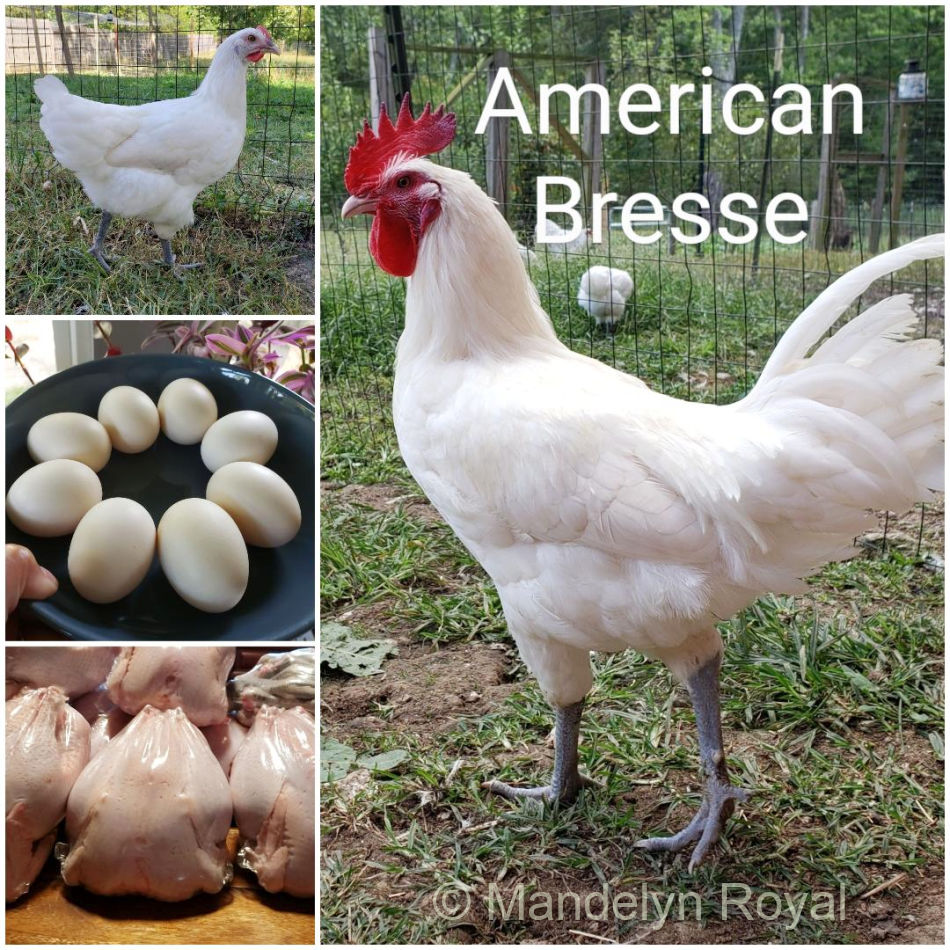
Photo credit: Mandelyn Royal.
